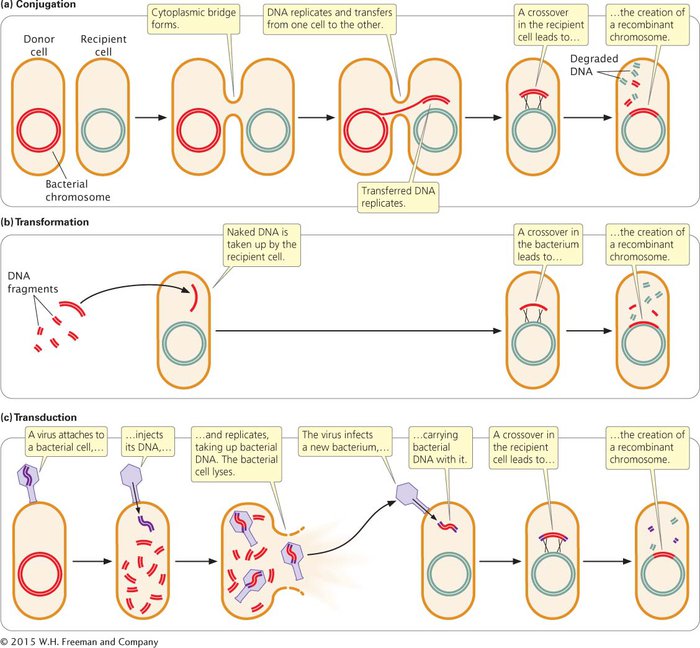7.2 Bacteria Exchange Genes through Conjugation, Transformation, and Transduction
Bacteria exchange genetic material by three different mechanisms, all entailing some type of DNA transfer and recombination between the transferred DNA and the bacterial chromosome.
Conjugation takes place when genetic material passes directly from one bacterium to another (Figure 7.7a). In conjugation, two bacteria lie close together and a connection forms between them. A plasmid or a part of the bacterial chromosome passes from one cell (the donor) to the other (the recipient). After conjugation, crossing over may take place between homologous sequences in the transferred DNA and the chromosome of the recipient cell. In conjugation, DNA is transferred only from donor to recipient, with no reciprocal exchange of genetic material.
Transformation takes place when a bacterium takes up DNA from the medium in which it is growing (Figure 7.7b). After transformation, recombination may take place between the introduced genes and those of the bacterial chromosome.
Transduction takes place when bacterial viruses (bacteriophages, or phages) carry DNA from one bacterium to another (Figure 7.7c). Inside the bacterium, the newly introduced DNA may undergo recombination with the bacterial chromosome.

Not all bacterial species exhibit all three types of genetic transfer. Conjugation takes place more frequently in some species than in others. Transformation takes place to a limited extent in many species of bacteria, but laboratory techniques can increase the rate of DNA uptake. Most bacteriophages have a limited host range, so transduction normally takes place between bacteria of the same or closely related species only.
These processes of genetic exchange in bacteria differ from diploid eukaryotic sexual reproduction in two important ways. First, DNA exchange and reproduction are not coupled in bacteria; bacteria often undergo reproduction (cell division) without receiving any DNA from another cell. Second, donated genetic material that is not recombined into the host DNA is usually degraded, so the recipient cell remains haploid. Each type of genetic transfer can be used to map genes, as we will see in the following sections.
CONCEPTS
DNA may be transferred between bacterial cells through conjugation, transformation, or transduction. Each type of genetic transfer consists of a one-
 CONCEPT CHECK 2
CONCEPT CHECK 2
Which process of DNA transfer in bacteria requires a virus?
Conjugation
Transduction
Transformation
All of the above
b